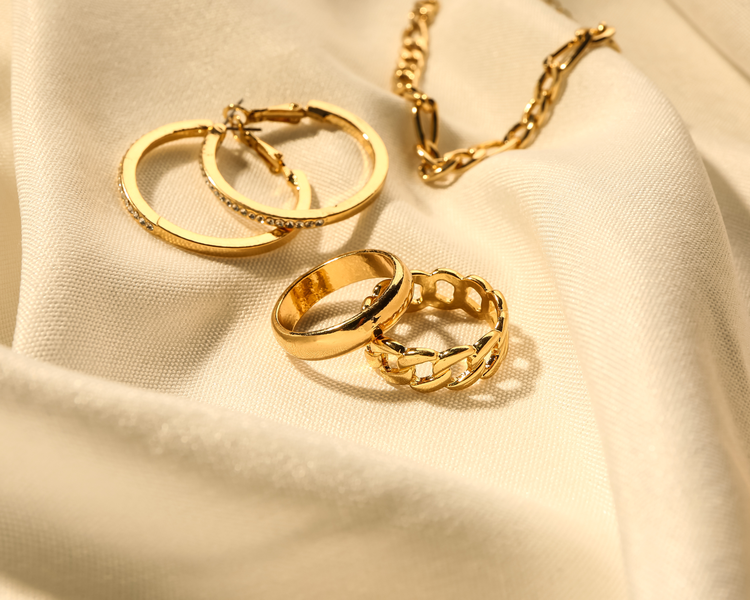In an age where sustainability and ethical responsibility are at the forefront of consumer values, recycled gold has emerged as a powerful alternative to traditionally mined gold. No longer just a niche option, it now plays a vital role in reshaping the jewellery industry by reducing environmental harm, addressing human rights concerns, and preserving the intrinsic quality and value of gold. From discarded electronics and old jewellery to industrial by-products, recycled gold is reclaimed through sophisticated processes that ensure purity and performance equal to that of newly mined metal. This article explores the journey of recycled gold—its origins, environmental and ethical significance, economic value, and how consumers can make informed, responsible choices when buying recycled gold jewellery.
Main Takeaways
- Recycled gold is a sustainable and ethical alternative to newly mined gold, with equivalent quality and purity.
- Sources include old jewellery, electronic waste, and industrial scraps, reducing the need for environmentally damaging mining.
- Refining processes like the Miller and Wohlwill methods ensure that high-purity gold is suitable for fine jewellery.
- Environmental benefits include lower carbon emissions, reduced energy use, and less ecological damage compared to mining.
- Ethical advantages involve avoiding support for conflict gold and exploitative labour, though it doesn’t directly aid small-scale miners.
- Economic value remains strong, with recycled gold offering competitive pricing and long-term investment potential.
- Consumer demand is driving brands toward transparency, certified sourcing, and innovative recycling technologies.
- Smart purchasing involves checking for certifications, supply chain transparency, and quality guarantees.

Understanding Recycled Gold
Recycled gold is becoming an important component in the production of sustainable jewellery. It offers environmental and ethical advantages while also maintaining good product quality. The journey of recycled gold—from its sources to its refinement and assurance of quality, is significant in today’s eco-conscious market.
The primary sources of recycled gold include old jewellery, electronic waste, and industrial scraps. Old jewellery, often out of fashion or broken, provides a substantial amount of recyclable gold. E-waste includes discarded electronic devices, such as smartphones, laptops, and televisions, which contain gold in components like connectors and circuit boards. Industrial scraps from sectors like dentistry and aerospace also contribute to the pool of recyclable gold.
The refining process of recycled gold is meticulous, and the final product matches the purity of newly mined gold. Collected gold materials are melted down, and the miller process, which involves introducing chlorine gas to molten gold, removes impurities. This method yields gold with a purity of 99.5%. For applications requiring higher purity, the Wohlwill process is employed. This electrochemical procedure uses chloroauric acid and an electric current to achieve gold purity levels up to 99.999%
Quality assurance is crucial in the production of recycled gold. When properly refined, recycled gold is chemically indistinguishable from newly mined gold. This equivalence guarantees that recycled gold meets the stringent standards required for jewellery and other high-quality applications.
Environmental Benefits
Recycled gold jewellery offers environmental advantages. It helps mitigate the ecological damage associated with traditional gold mining.
Gold mining often leads to deforestation, habitat destruction, and water pollution due to the use of toxic chemicals like cyanide and mercury. Utilising recycled gold allows the demand for newly mined gold to decrease.
The process of recycling gold consumes considerably less energy compared to mining. A study published in the Journal of Cleaner Production found that high-value gold scrap recycling results in a cumulative energy demand of 820 MJ and a global warming potential of 53 kg CO₂-equivalent per kilogram of gold. In contrast, primary gold mining requires approximately 240 GJ of energy and emits about 16 t CO₂-equivalent per kilogram of gold, making recycling a substantially more energy-efficient and lower-emission alternative.
Recycling gold also promotes a circular economy by encouraging the reuse of existing materials, thereby reducing waste and conserving natural resources. This approach aligns with the Sustainable Development Goals by minimising the environmental footprint of gold production and supporting more responsible consumption patterns.
Ethical Considerations
Beyond environmental benefits, recycled gold jewellery addresses several ethical concerns prevalent in the gold mining industry.
Traditional gold mining has been linked to human rights abuses, including child labour, unsafe working conditions, and funding of armed conflicts through the trade of so-called “blood gold.” Opting for recycled gold can help consumers avoid contributing to these unethical practices, as recycled gold is sourced from existing materials rather than conflict zones. However, the recycled material could already be coming from unethical practices.
The use of recycled gold supports fair labour practices by reducing reliance on mining operations that may exploit workers. The jewellery industry is increasingly expected to uphold high ethical standards, and incorporating recycled gold into production processes is a step toward meeting these expectations. However, it’s essential to note that while recycled gold addresses certain ethical concerns, it does not directly improve the working conditions of small-scale miners who rely on gold mining for their livelihoods. Therefore, some experts advocate for sourcing gold from certified ethical mining operations, such as those accredited, to ensure comprehensive ethical responsibility.

Economic and Quality Aspects
Recycled gold can often be more cost-effective than newly mined gold due to its reduced production expenses. According to the World Gold Council and Boston Consulting Group, recycled gold accounted for approximately one-third of the total supply by the 2010s and offers little to no price premium over mined gold.
Additionally, high-efficiency recycling methods—such as those utilised in modern European refineries—demand only a fraction of the energy required for mining, further lowering overhead and enabling more competitive pricing.
Beyond affordability, recycled gold retains its intrinsic value over time. It can be viewed as both a fashion accessory and an investment vehicle. Industry observers have highlighted the dual appeal of recycled gold: acting as a symbol of personal values—such as ethical sourcing and sustainability—while also offering the time-tested benefits of gold’s longevity and hedging properties, as reflected in jewellery. This makes recycled gold jewellery an attractive option for consumers seeking both aesthetic appeal and financial resilience.
Market Trends and Consumer Demand
Consumer demand for ethically produced, sustainable jewellery has accelerated the market shift toward recycled gold. Large-scale brands have responded swiftly; for instance, some brands have reported using 99 per cent repurposed gold in 2024 and aim for fully sustainable sourcing by 2025.
Smaller, intentional brands are also emerging, prioritising transparency and eco-conscious materials to meet growing consumer expectations.
The rise of recycled gold is reflected in the efforts of eyewear and fashion leaders. Brands claim they use 100 per cent recycled gold, a move estimated to reduce their carbon footprint by over 99 per cent compared to traditional mining. This shift highlights a broader recognition that recycled metals can significantly reduce environmental impacts while aligning with evolving consumer values.
Entrepreneurs are further pioneering innovative approaches by reclaiming gold from e-waste sources such as old mobile phones and circuit boards. These initiatives utilise emerging technologies that can recover gold at room temperature, boosting recovery rates above 99 per cent and drastically reducing greenhouse gas emissions compared to mining.
As e-waste continues to accumulate globally, such methods are transforming waste into both ethical resources and compelling jewellery narratives, reinforcing recycled gold’s growing appeal among sustainability-minded consumers.

How to Choose Recycled Gold Jewelry
When selecting recycled gold jewellery, it is crucial to consider several key factors that ensure ethical sourcing, brand integrity, and product quality.
One important consideration is certification. Some schemes provide third-party verification that mined or recycled gold meets rigorous standards for labour rights, environmental stewardship, and traceability. According to a study published on ScienceDirect, certification systems can ensure responsible practices from artisanal and small-scale miners, including fair pricing and community investment. These certifications offer consumers confidence that their jewellery supports ethical supply chains.
Transparency is another element in selecting recycled gold pieces. Brands that openly share information about the origins of their metals and their manufacturing processes foster trust with conscientious buyers. Experts also advise consumers to ask specific questions about a brand’s supply chain and certifications to avoid vague or misleading claims.
Quality assurance should not be overlooked. Since recycled gold chemically matches newly mined gold, purity levels are equivalent, but diligent verification remains essential. Research confirms that recycled gold possesses the same composition and value as its mined counterpart.
Therefore, buyers should seek assurances—such as assay certificates or manufacturer guarantees—that confirm the gold’s karat purity, craftsmanship standards, and even warranties for long-term care.
Conclusion
Recycled gold represents a meaningful shift in the jewellery industry toward more sustainable, ethical, and responsible practices. By reclaiming gold from existing sources—such as outdated electronics, unused jewellery, and industrial waste—we can significantly reduce the environmental impact and ethical concerns tied to traditional mining. Advanced refining techniques ensure that recycled gold meets the highest standards of purity and quality, making it indistinguishable from newly mined gold.
As consumer awareness grows, so does the demand for transparency, certification, and environmental accountability. Choosing recycled gold jewellery not only supports a circular economy but also aligns personal style with values like sustainability and social responsibility. While it may not solve all the challenges facing the gold industry, recycled gold is a critical step toward a cleaner, fairer future—both for the planet and the people who inhabit it.



